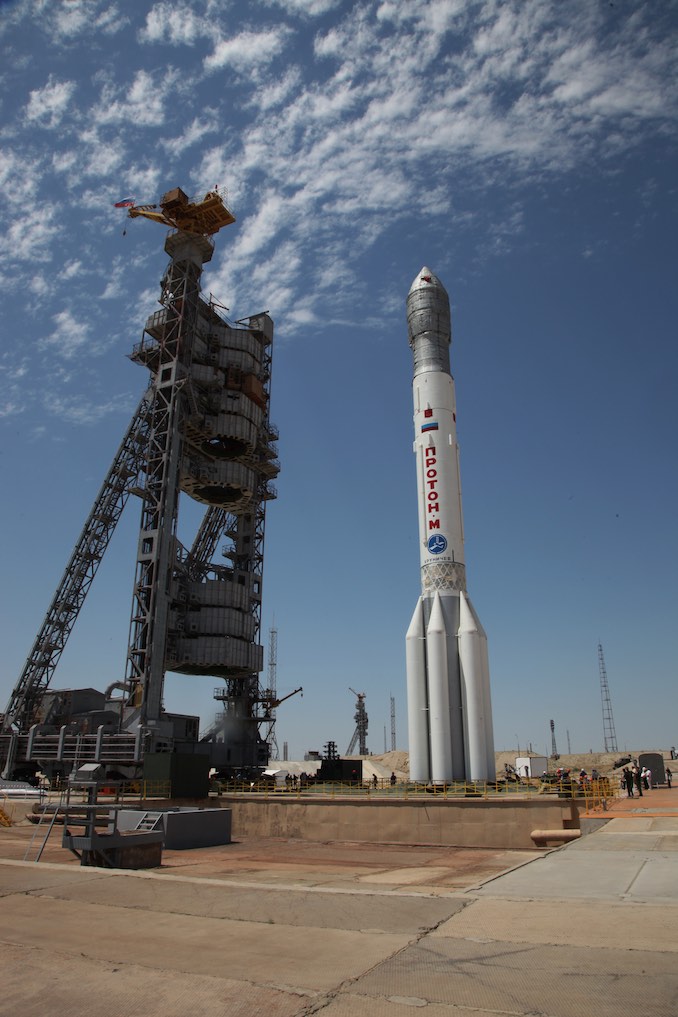A rocket-transporting railroad car ferried a Proton booster to its launch pad Friday at the Baikonur Cosmodrome in Kazakhstan for final checkouts and testing before the vehicle’s scheduled June 21 liftoff with the Russian-German Spektr-RG X-ray telescope.
The Proton rocket began the trip to the Complex 81 launch pad Friday at around 6:30 a.m. local time in Kazakhstan. After pulling up to the pad, a hydraulic lift raised the rocket vertical, and ground crews moved a mobile gantry around the launcher to provide access for workers to complete inspections, testing and closeouts before next week’s launch.
Liftoff is scheduled for 1217:14 GMT (8:17:14 a.m. EDT; 5:17:14 p.m. Baikonur time) on June 21 to send the Spektr-RG astronomy observatory toward the L2 Lagrange point, a gravitationally neutral point about a million miles (1.5 million kilometers) from the night side of Earth.
Proton rockets are usually rolled out to the launch pad a few days before liftoff, but ground teams transferred the Proton launcher with Spektr-RG to the pad a week before liftoff. According to Roscosmos, the Russian space agency, workers will complete checks on the spacecraft, the Proton booster, and the rocket’s Block DM upper stage, and carry out “comprehensive tests” on the control system of the launch vehicle.
Ground teams will also inspect ground equipment at the launch pad before next Friday’s launch, Roscosmos said in a statement.
The launch of Spektr-RG will mark the first flight of a Block DM upper stage with a Proton rocket since September 2015. Recent Proton missions have typically launched with the newer-design Breeze M upper stage to place their payloads into high-altitude orbits.
The three-stage Proton booster features a six-engine first stage producing 2.5 million pounds of thrust, and a four-engine second stage that generates 540,000 pounds of thrust. The Proton’s third stage is powered by a single main engine delivering 131,000 pounds of thrust.
The reignitable Block DM upper stage will separate from the Proton’s third stage less than 10 minutes after liftoff, followed by two burns of the Block DM main engine before deployment of the 5,980-pound (2,712.5-kilogram) Spektr-RG spacecraft two hours into the mission.
All of the engines on the Proton booster and the Block DM upper stage consume a toxic mixture of hydrazine and nitrogen tetroxide propellants.
After arriving at its distant observing post, Spektr-RG will begin a six-and-a-half-year mission surveying the sky with twin X-ray telescopes.
Spektr-RG is a joint project between Roscosmos and DLR, the Russian and German space agencies. The mission will conduct an all-sky X-ray survey, observing galaxies and large-scale galactic clusters to help astronomers examine the role of dark energy and dark matter in the evolution of the universe.
The primary instrument on Spektr-RG is the German-built wide-field eROSITA X-ray telescope, which scientists say will observe more than 3 million active black holes at the centers of galaxies, and approximately 100,000 clusters of galaxies in the distant universe.
A second X-ray telescope on Spektr-RG, developed by a Russian science team, will be sensitive to higher-energy X-rays than eROSITA. The Russian telescope, named ART-XC, will fly with X-ray mirror modules fabricated at NASA’s Marshall Space Flight Center in Alabama.
Officials from the Russian and German space agencies signed an agreement to collaborate on the Spektr-RG mission in 2009. Spektr-RG is the biggest Russian space science mission to launch since 2011.
More photos of the Proton rocket’s rollout Friday are posted below.























Email the author.
Follow Stephen Clark on Twitter: @StephenClark1.



